
Dioryctria abietella is a moth of the family Pyralidae. It is found in Europe.
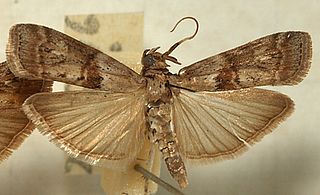
Phycita roborella is a moth of the family Pyralidae. It is – under its junior synonym Tinea spissicella – the type species of its genus Phycita, and by extension of the subfamily Phycitinae.

Agriphila selasella is a species of moth of the family Crambidae. It was described by Jacob Hübner in 1813 and is found in Europe and east across the Palearctic.

Evergestis extimalis is a species of moth of the family Crambidae. It is found in the Palearctic.

Cataclysta lemnata, the small china-mark, is a moth species of the family Crambidae. It is found in Europe, Morocco and Iran.

Chilo phragmitella is a species of moth of the family Crambidae, sometimes referred to by the vernacular names wainscot veneer or reed veneer. It was first described by Jacob Hübner between 1805 and 1810 as Tinea phragmitella, and is the type species of the genus Chilo.
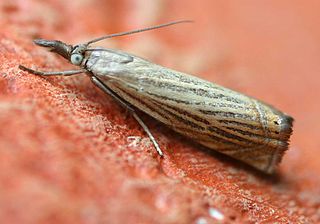
Chrysoteuchia culmella, the garden grass-veneer, is a species of moth of the family Crambidae. It was first described by Carl Linnaeus in his 1758 10th edition of Systema Naturae. It is found in Europe.

Donacaula forficella is a species of moth of the family Crambidae described by Carl Peter Thunberg in 1794. It is found in China (Heilongjiang), Europe and South Africa.

Anania crocealis is a species of moth of the family Crambidae. It was described by Jacob Hübner in 1796 and is found in Europe.

Anania lancealis is a species of moth of the family Crambidae, described by the Austrian lepidopterists Michael Denis and Ignaz Schiffermüller in 1775. The moth is found in Asia and Europe.

Anania coronata, the elderberry pearl, elder pearl or crowned phlyctaenia, is a species of moth of the family Crambidae. It was described by Johann Siegfried Hufnagel in 1767 and is found in the northern parts of the Palearctic realm. It was previously also listed for the Nearctic realm. The species closely resembles Anania stachydalis.
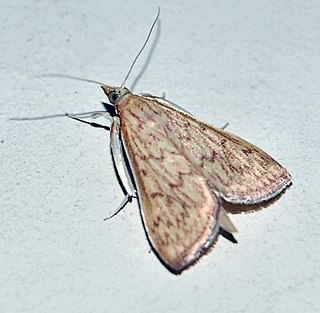
Antigastra catalaunalis is a species of moth of the family Crambidae. The species was first described by Philogène Auguste Joseph Duponchel in 1833. It is endemic to tropical and subtropical areas, but is also found in other areas due to its migratory nature.
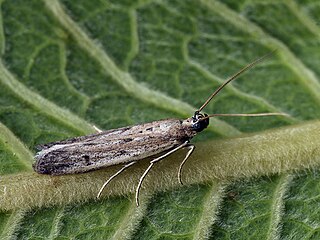
Homoeosoma nebulella, the Eurasian sunflower moth, is a moth of the family Pyralidae. It is found in Europe, Russia, Anatolia, the Middle East and West Africa. The wingspan is 20–27 mm.The forewings are pale whitish ochreous, tinged with grey and sprinkled with dark grey, towards costa suffused with whitish; first line indicated by two blackish dots, upper more remote from base; second faintly darker-edged, usually preceded by a dark fuscous subdorsal dot; two blackish transversely placed discal dots. The hindwings are subhyaline, fuscous-tinged, the veins and termen fuscous. Larva dull greenish-yellow dorsal and broader subdorsal lines dull purple; spiracular interrupted, double, dull purple; head brown: in flower-heads of Carduus

Laelia coenosa, the reed tussock, is a moth of the family Erebidae. The species was first described by Jacob Hübner in 1808. It is found in North Africa, southern and central Europe, through Russia and eastern Asia up to Japan.
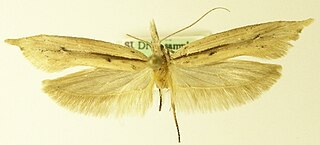
Ypsolopha mucronella is a moth of the family Ypsolophidae. It is found from Europe, through Siberia to Japan and in Asia Minor.

Elachista gleichenella is a moth of the family Elachistidae found in most of Europe.

Elachista alpinella is a moth of the family Elachistidae found in Europe and North America.
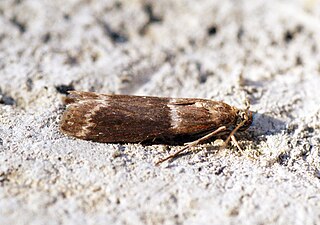
Cryptoblabes bistriga is a species of snout moth in the genus Cryptoblabes. It was described by Adrian Hardy Haworth in 1811. It is found in most of Europe, except Portugal, parts of the Balkan Peninsula and Ukraine.
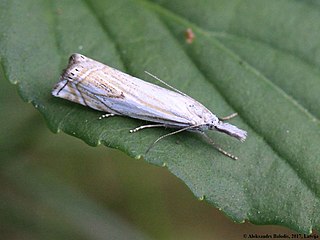
Crambus uliginosellus is a species of moth in the family Crambidae. It was first described by Zeller in 1850 and is currently found in most of Europe, except Portugal, Slovenia, Croatia and Ukraine.
Donacaula dodatellus is a moth in the family Crambidae. It was described by Francis Walker in 1864. It is found in China (Yunnan), Japan, India, Myanmar, Sri Lanka, the Philippines and on Sumatra.




















